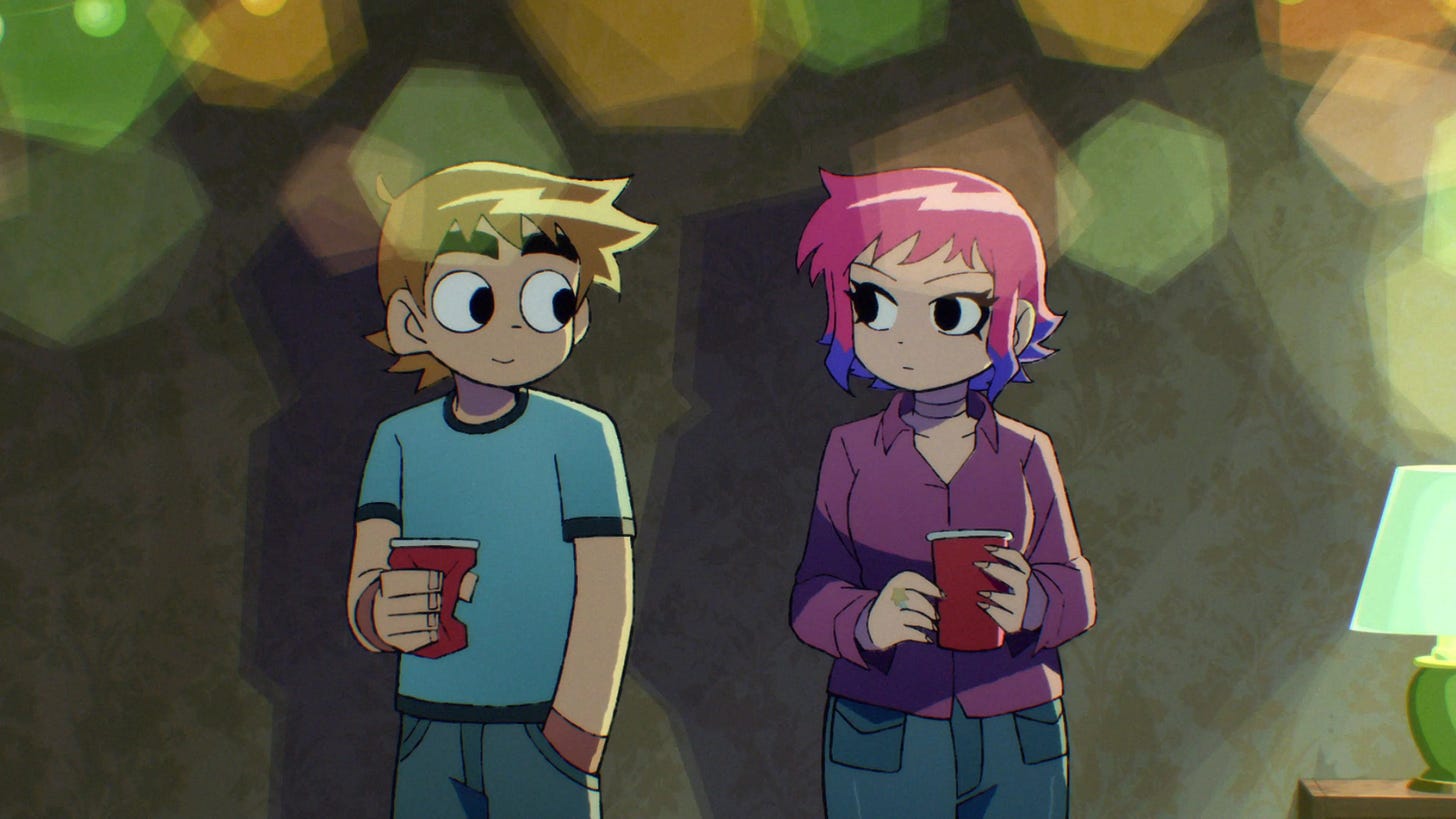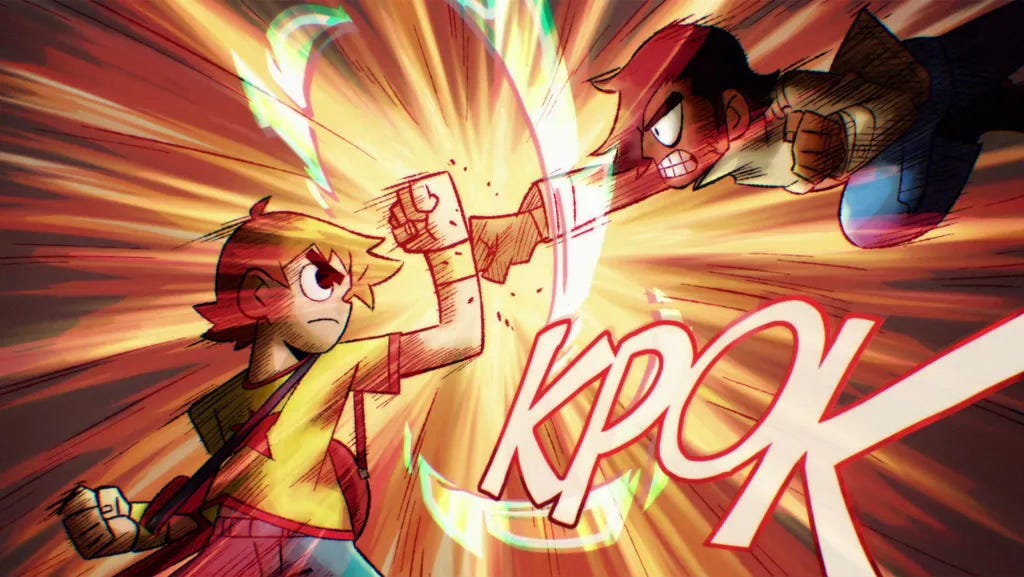[Spoilers ahead for the Scott Pilgrim comics, movie, and Netflix series]
Both Bryan Lee O’Malley’s graphic novel series, Scott Pilgrim, and the 2010 film adaptation, Scott Pilgrim vs. the World, end the same way despite some differences in how they arrive at the ending. Scott Pilgrim, an endearing but immature guy in his early 20s, falls for delivery girl Ramona Flowers, but to continue to date her, he must defeat her Seven Evil Exes, a quest that fractures their relationship but forces both of them to grow as individuals. It’s a story about being young, trying to learn about another person when you’re still learning about yourself, and then seeing if you can be better without your baggage.
When it was announced that Netflix would adapt O’Malley’s books into an animated series, but with the actors from the movie voicing their characters, I assumed the result would be more faithful to O’Malley’s books. Instead, O’Malley and co-writer BenDavid Grabinski made a radical departure that not only took Scott Pilgrim to the next level, but allowed me, now in my late 30s, to still relate to a character and story I found so captivating in my early 20s.
Scott Pilgrim and Me

It’s difficult to stress how much I was into Scott Pilgrim in my 20s. I started reading the books shortly after graduating college, and really tapped into the central character who was both relatable and oddly aspirational. Scott’s not a “good” guy, but he’s also not a horrible one. He’s just like a lot of guys in their early 20s—kind of stupid, goofy, and in a state of arrested development where he’s clinging to the stuff he understands (video games, playing music) rather than growing up. While I didn’t relate to everything Scott did (the book starts with Scott “dating” a high-schooler in an incredibly chaste fashion whereas I did not date anyone for almost the entirety of my 20s), I liked his cheery disposition, and the idea that dating could be as straightforward as literally and figuratively fighting for the girl of your dreams (Ramona and Scott first meet as she’s traveling through the “subspace highway” of his dreams as a shortcut for her Amazon deliveries).
However, now in my late 30s, Scott Pilgrim is more about a certain point in my life than an enduring figure that I always relate to. I’m happily married, I have a much better sense of who I am and what I want then I did in my early 20s, and while I still play quite a few video games, I’ve expanded my range of interests. I figured that the new series would be a nice nostalgia trip and nothing more.
And then Grabinski and O’Malley completely changed the game.
Scott Pilgrim Goes to the Next Level

[Seriously, major spoilers ahead for Scott Pilgrim Takes Off]
In the books and the movie, the first evil ex fight is against Ramona’s middle school boyfriend, Matthew Patel, and Scott beats Matthew. In Scott Pilgrim Takes Off, Matthew beats Scott, and it appears that Scott is dead. The story then shifts to Ramona’s point of view as she investigates what happened to Scott by looking into her exes. Meanwhile, the League of Evil Exes is also undergoing massive changes as Matthew defeats the head of the League, Gideon Graves. This all makes the title of the show a great pun, since the story is not only a “take off” of the original material—but also Scott is now gone, so he has “taken off.”
So what is a Scott Pilgrim story without Scott Pilgrim? Pretty interesting! The first three-quarters of the show is Ramona looking into her exes, and it’s a great repositioning because while the comics and the movie look at relationship baggage as something that has to be disposed of, the Netflix series forces Ramona and her exes to confront their own failings. Rather than the exes being obstacles in Scott’s path with Ramona as the prize, Ramona and her exes now have to face themselves in the cold light of day, and no one is “evil” as much as woefully misguided and capable of redemption. It’s a more mature and compassionate way to look at these characters where no one needs to be “defeated” even though the show still has fight scenes. Instead, the larger question is what would happen if these characters were allowed to grow up?
That leads us back to Scott, who wasn’t killed by Matthew, but instead abducted into the future by his future self, 37-year-old Scott (brilliantly voiced by Will Forte). Older Scott abducted younger Scott so that younger Scott would never get with Ramona, thus sparing Older Scott the heartbreak of losing Ramona when she dumped him later in life. What’s striking about Older Scott is that he hasn’t grown up at all. He doesn’t seem particularly bothered that future Toronto appears kind of dystopian; he’s still crashing with Wallace Wells; and his big solution to dealing with heartbreak is to mess with time and space. He is, like his younger self, kind of a loser, but also blissfully unaware that he’s kind of a loser.
Rather than rehashing the comics or the movie, which are both (for better and worse), products of the 2000s, the Netflix series is about the dangers of stagnation. Grabinski and O’Malley walked a delicate balance between staying true to the spirit of the story while interrogating what the original story was doing, and why it needed an update. There are plenty of elements of Scott Pilgrim that feel timeless, whether it’s the lack of direction of your early 20s or simply throwing in a lot of references to anime and video games. Scott Pilgrim Takes Off isn’t trying to trash what came before, but it’s also wisely acknowledging that both its creator and its fans are older now.
Watching the Netflix series, I felt oddly grateful that Scott Pilgrim had grown up with me rather than try to pull me back into my 20s. My 20s weren’t all that great in retrospect, and while I’m glad they forced me to mature, I don’t want to necessarily pretend that Scott Pilgrim is synonymous with the best times of my life. The gift of the new series is nodding to the past, but also choosing to do something different. In a media landscape where far too much of fandom demands utmost fidelity to the thing they fell in love with, Scott Pilgrim Takes Off shows the beauty of maintaining the soul of the original idea but rethinking it, reconstructing it, and creating something that feels both familiar and new. Scott Pilgrim isn’t the same story it used be, and Scott Pilgrim Takes Off makes that a victory for everyone.




A terrific review with a personal dimension that makes it more than a review -- a little journey of self-discovery alongside insights about fandom, spin-offs and continuations, and changing values.